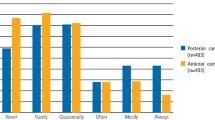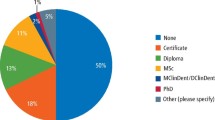Key Points
-
The use of posterior composites appears to be increasing.
-
Techniques used are in line with current thinking.
-
For posterior composites there is some confusion over the need for rubber dam and use of lining materials.
-
There is also confusion over the most appropriate restorative material to use in a pregnant patient.
Abstract
Objective To determine the opinions and current methods used in placing posterior composite restorations by general dental practitioners.
Setting The study was completed by general dental practitioners randomly selected from across the UK.
Method A questionnaire was devised to gain this information. It was sent to 500 UK dentists chosen at random from the general dental register, with an explanatory letter and reply-paid envelope.
Results Two hundred and sixty-seven replies were received. Sixty-one percent of dentists felt amalgam use had decreased over the last five years, 75% felt posterior composite use had increased. Regarding choice of posterior material, almost all cited clinical indication as the most influential factor while patient's aesthetic demands (89%), wish for a certain material (78%) and the dentist's confidence using a certain restorative material (76%) were contributing factors. Regarding the techniques used, contemporary techniques were employed although there was confusion regarding the need for rubber dam and the most appropriate method of lining the cavity. A case scenario of a pregnant patient who required treatment found that 66% of respondents would place a restoration other than a temporary dressing, with 16% placing an amalgam restoration.
Conclusions The majority of dentists surveyed place load bearing posterior composite restorations regularly. Their choice of restorative material is influenced by clinical indications and the patient's aesthetic demands. The techniques used were appropriate, although there was confusion around the need for rubber dam and the most appropriate method to line the cavity. There was also confusion in relation to the most appropriate materials for use in pregnancy.
Similar content being viewed by others
Log in or create a free account to read this content
Gain free access to this article, as well as selected content from this journal and more on nature.com
or
References
Minguez N, Ellacuria J, Soler J I, Triana R, Ibaseta G . Advances in the history of composite resins. J Hist Dent 2003; 51: 103–105.
Hickel R, Manhart J . Longevity of restorations in posterior teeth and reasons for failure. J Adhes Dent 2006; 3: 45–64.
Marghalani H Y, Al-jabab A S . Compressive creep and recovery of light-cured packable composite resins. Dent Mater 2004; 20: 600–610.
Opdam N J M, Bronkhorst E M, Joost M R, Loomans B A C . A retrospective clinical study on longevity of posterior composite and amalgam restorations. Dent Mater 2007; 23: 2–8.
Kelly M, Steele J, Nuttall N et al. Adult dental health survey. Oral health in the United Kingdom 1998. pp 112. London: TSO, 2000.
Burke F J T, McHugh S, Hall A C, Randall R C, Widstrom E, Forss H . Amalgam and composite use in UK general dental practice in 2001. Br Dent J 2003; 194: 613–618.
Lynch C D, McConnell R J, Wilson N H F . Challenges to teaching posterior composites in the United Kingdom and Ireland. Br Dent J 2006; 201: 747–750.
Forss H, Widstrom E . From amalgam to composite: selection of restorative materials and restoration longevity in Finland. Acta Odontol Scand 2001; 59: 57–62.
Bogacki R E, Hunt R J, Aguila M, Smith W R . Survival analysis of posterior restorations using an insurance claims database. Oper Dent 2002; 27: 488–492.
Burke F J T, McHugh S, Randall R C, Meyers I A, Pitt J, Hall A C . Direct restorative materials use in Australia in 2002. Aust Dent J 2004; 49: 185–191.
Chadwick B L, Treasure E T, Dummer P M H et al. Challenges with studies investigating the longevity of dental restorations – a critique of a systematic review. J Dent 2001; 29: 155–161.
Gilbert J A . Posterior composites: an ethical issue. Oper Dent 1987; 12: 79–81.
Strydom C . Handling protocol of posterior composites. Rubber dam. SADJ 2005; 60: 292–293.
Terry D A . An essential component to adhesive dentistry: the rubber dam. Pract Proced Aesthet Dent 2005; 17: 106, 108.
Brunthaler A, Konig F, Lucas T, Sperr W, Schedle A . Longevity of direct resin composite restorations in posterior teeth. Clin Oral Investig 2003; 2: 63–70.
Lynch C D, McConnell R J, Wilson N H F . Teaching of posterior composite resin restorations in undergraduate dental schools in Ireland and the United Kingdom. Eur J Dent Educ 2006; 10: 38–43.
Unemeri M, Matsuya Y, Akashi A, Goto Y, Akamine A . Composite resin restoration and postoperative sensitivity: clinical follow-up in an undergraduate program. J Dent 2001; 29: 7–13.
Akpata E S, Sadiq W . Post-operative sensitivity in glass ionomer versus adhesive resin-lined posterior composites. Am J Dent 2001; 14: 34–38
Peumans M, Van Meerbeek B, Asscherickx K et al. Do condensable composites help to achieve better proximal contacts? Dent Mater 2001; 17: 533–541.
Neiva I F, deAndrada M A C, Baratieri L N, Moneiro S, Ritter A V . An in vitro study of the effect of restorative techniques on marginal leakage in posterior composites. Oper Dent 1998; 23: 282–289.
Mullejans R, Badawi M O F, Raab W H M, Lang H . An in vitro comparison of metal and transparent matrices used for bonded class II resin composite restorations. Oper Dent 2003; 28: 122–126.
Burke F J T, Shortall A C C . Successful restoration of load bearing cavities in posterior teeth with direct-replacement resin-based composite. Dent Update 2001; 28: 388–398.
Mjor I A, Burke F J T, Wilson N H F . The relative cost of different restorations in the UK. Br Dent J 1997; 182: 286–289.
Opdam N J . The future of dental amalgam. Ned Tijdschr Tandheelkd 2005; 112: 373–375.
Wilson N H F, Dunne S M, Gainsford I D . Current materials and techniques for direct restorations in posterior teeth. Part 2: resin composite systems. Int Dent J 1997; 47: 185–193.
Gaengler P, Hoyer I, Montag R . Clinical evaluation of posterior composites restorations: the 10 year report. J Adhes Dent 2001; 3: 185–194.
Roeters F J M, Opdam N J M, Loomans B A C . The amalgam free dental school. J Dent 2004; 32: 371–377.
Department of Health. Precautionary advice on dental amalgam fillings. (Press release). London: Department of Health, 1998. http://www.dh.gov.uk/en/Publicationsandstatistics/Pressreleases/DH_4024646
Author information
Authors and Affiliations
Corresponding author
Additional information
Refereed Paper
Rights and permissions
About this article
Cite this article
Gilmour, A., Evans, P. & Addy, L. Attitudes of general dental practitioners in the UK to the use of composite materials in posterior teeth. Br Dent J 202, E32 (2007). https://doi.org/10.1038/bdj.2007.472
Accepted:
Published:
Issue date:
DOI: https://doi.org/10.1038/bdj.2007.472
This article is cited by
-
Attitudes of dentists and interns in Riyadh to the use of dental amalgam
BMC Research Notes (2016)
-
Teaching of direct posterior resin composite restorations in UK dental therapy training programmes
British Dental Journal (2010)



